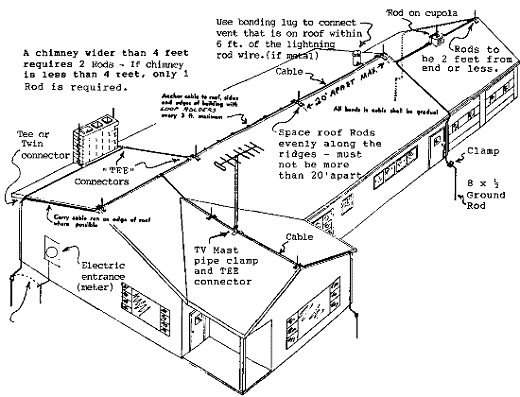|
Cameron & Sons
Lightning Rod Installation
Serving the Maritimes since 1940

Typical
House Lightning Protection Installation Procedure
(Study this diagram one section at a
time.)

If possible, place one Ground Rod near
the electric service ground and make a connection to the ground wire - use
Multi-purpose clamp and a short piece of wire. You can make a small trench
and bury the wire.
If you have a cupola with a weathervane,
you need a bolted clamp and a short piece of cable; make a connection to
the vane pole. If no vane, install a Rod on top of the cupola.
 |
|
 |
AIR TERMINALS
Rear view of roof ridge showing course of conductor and air
terminal on back side. Only slender point is visible from front of
home. |
|
SEMI-CONCEALED
CABLES
Conductor cables are semi-concealed on back
side of ridges and on facer board (a) at end of
house. |
 |
Ground Rod is easily driven in with a heavy
hammer or you can bury a ground plate instead of a ground
rod. |
 |
GENERAL DESIGN
RULES
All buildings must have two groundings as widely separated as possible,
preferably at diagonally opposite corners if perimeter, distance around,
is 250 feet or less.
If building perimeter is between 250 feet and 350 feet, then three
groundings are required. If between 350 feet and 450 feet, then four
groundings, etc.
Lightning Protection Systems shall be applied to metal covered
buildings in like manner as on buildings without metal coverings.
Cables shall be free of sharp turns and "u" or "v" pockets. Cables
shall maintain a horizontal or downward course.












|